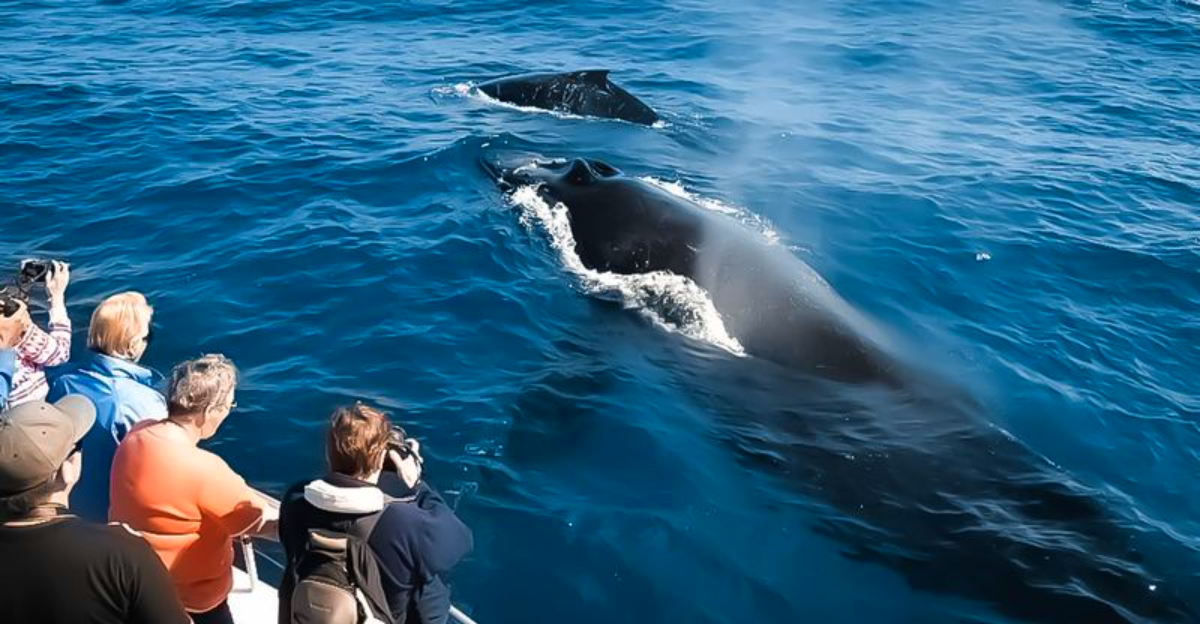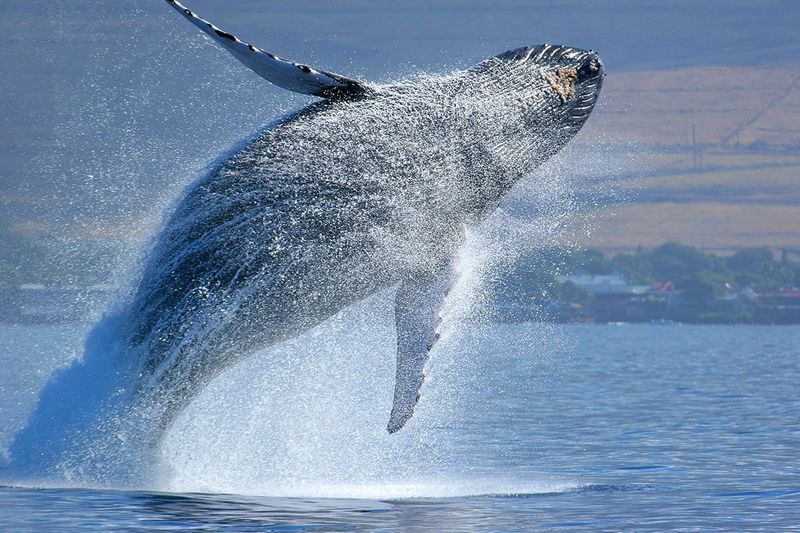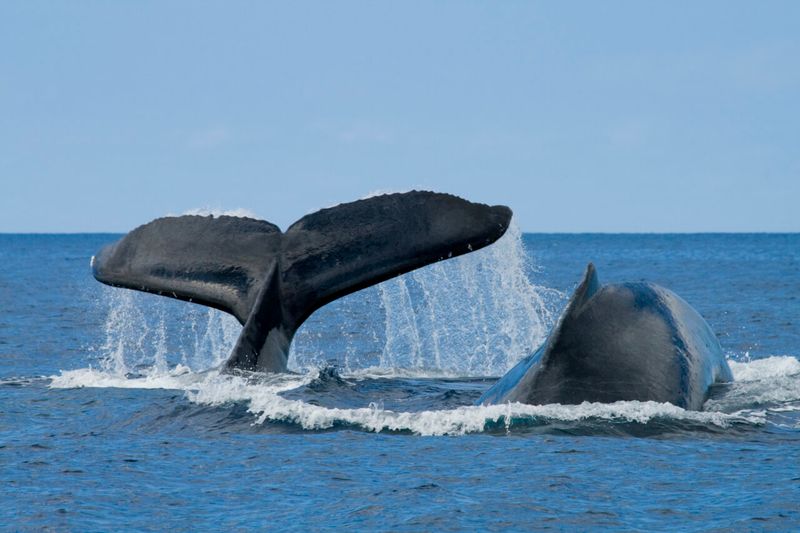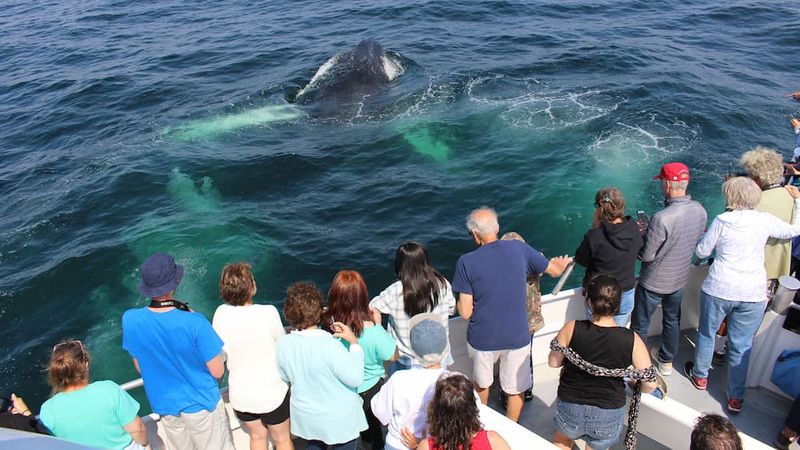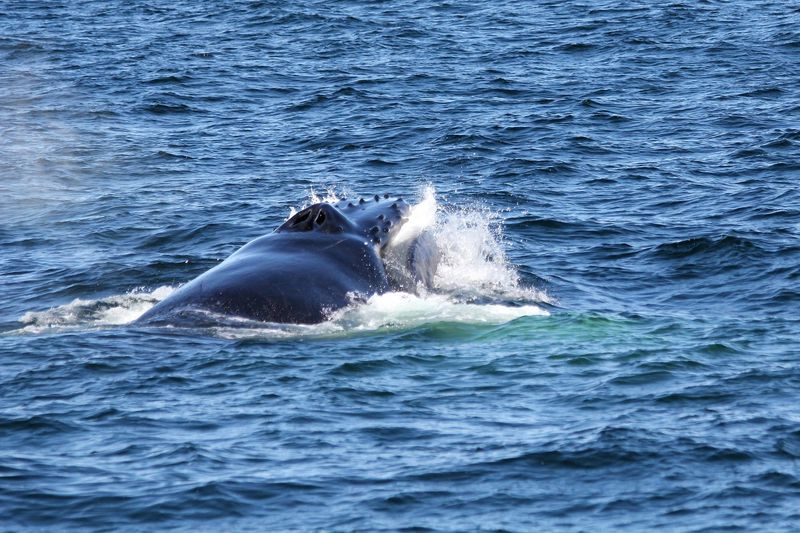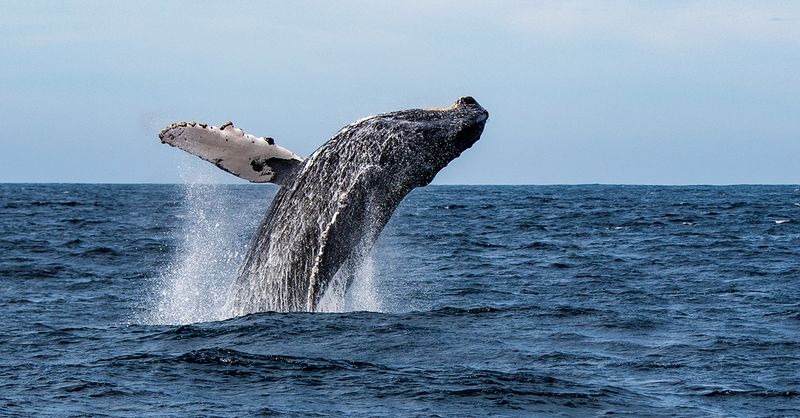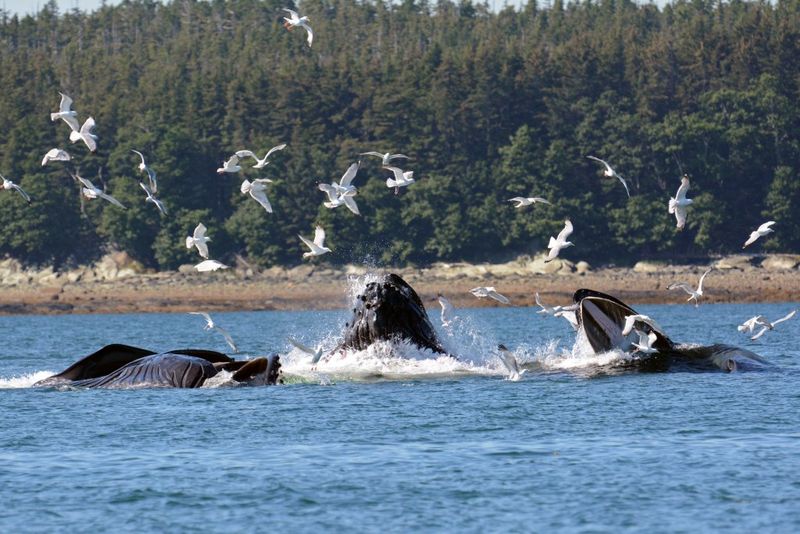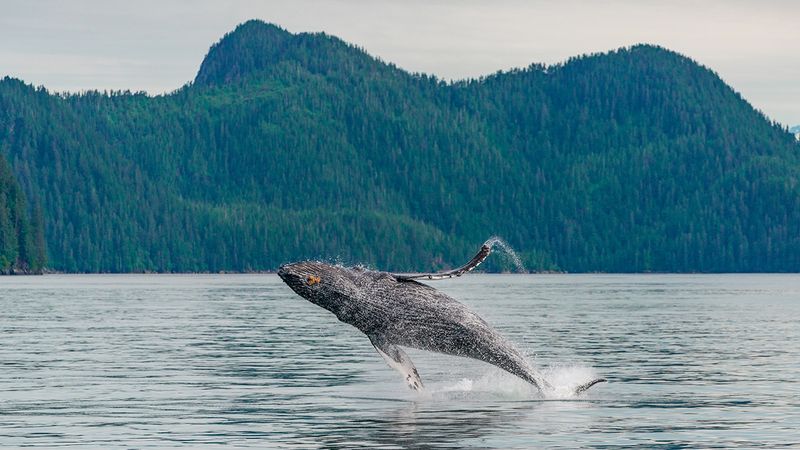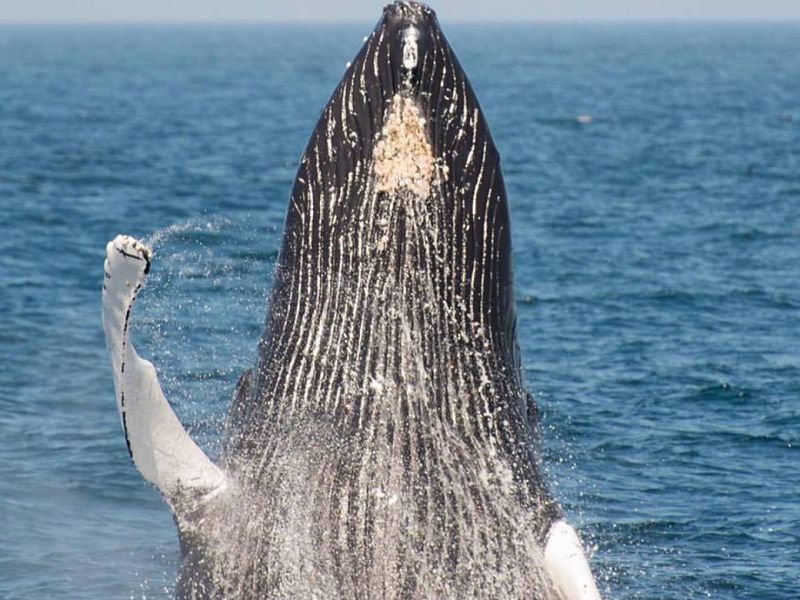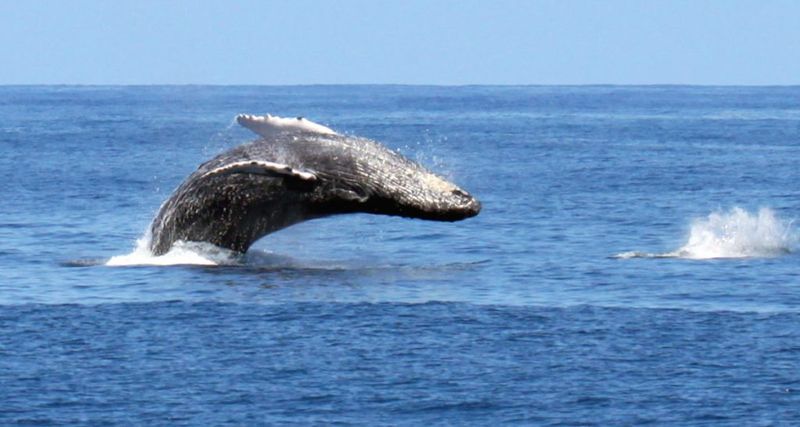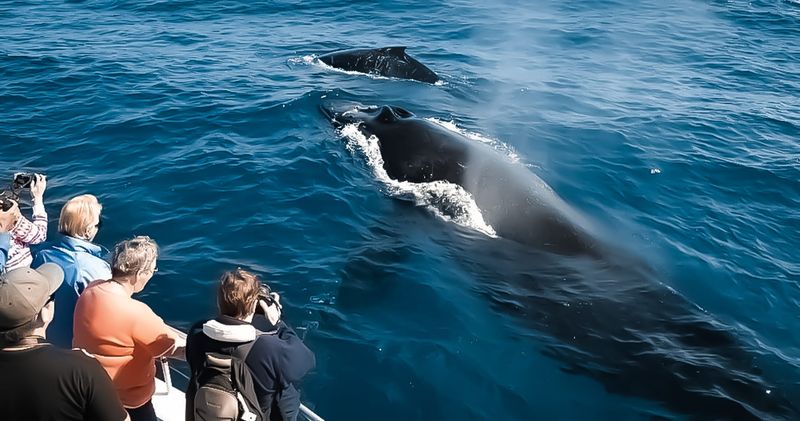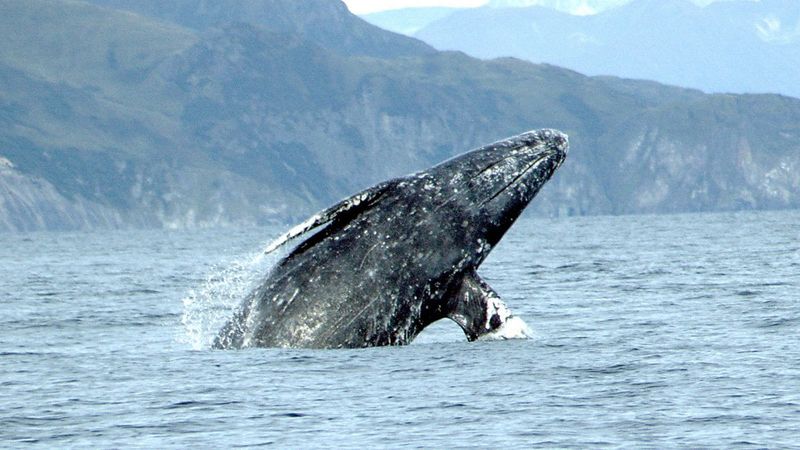When most people think about whale watching in America, California’s coast usually comes to mind first. But here’s a secret: some of the country’s most incredible whale-watching adventures happen far from the Golden State. From Alaska’s icy waters to Puerto Rico’s tropical shores, dozens of hidden gems offer close encounters with humpbacks, orcas, and other magnificent creatures that will leave you speechless.
1. Maui, Hawaiʻi (Maʻalaea / Kīhei)
Thousands of humpback whales travel to Maui’s warm waters every winter, creating one of nature’s most spectacular shows. Between December and April, these gentle giants come here to mate and raise their calves, with peak viewing happening from January through March. The entire area sits within Hawaii’s dedicated humpback sanctuary, which means these waters are protected specifically for whale conservation.
Watching a 40-ton whale leap completely out of the water is something you’ll never forget. Tours leave from Maʻalaea Harbor and Kīhei, often spotting mothers teaching their babies to breach and slap their tails.
After your ocean adventure, grab lunch at Paia Fishmarket for some of the freshest fish plates on the island.
2. San Juan Islands, Washington (Friday Harbor, Orcas Island)
Orcas aren’t just movie stars; they’re the real celebrities of the San Juan Islands. Bigg’s orcas, also called transient orcas, patrol these waters hunting seals from April through October, though you might spot them year-round if you’re lucky. Late summer and fall also bring humpback and minke whales cruising through the nutrient-rich channels between the islands.
What makes this spot extraordinary is how close the whales come to shore. Sometimes you can watch them from the ferry or even from beaches around Friday Harbor.
The scenery alone is worth the trip, with evergreen forests meeting sparkling blue water. Finish your day at Downriggers on the waterfront for fresh seafood and sunset views.
3. Depoe Bay, Oregon (Whale Watching Center & Nearshore Boats)
Gray whales pass by Depoe Bay twice a year during their epic migration, heading south from December to January and returning north from March through June. But here’s what most people don’t know: some gray whales actually stick around all summer, feeding in the shallow waters just offshore from June through mid-November.
The Oregon State Parks Whale Watching Center gives you a perfect land-based view, and volunteers are there to help you spot spouts and flukes. Depoe Bay calls itself the whale-watching capital of the Oregon coast, and it’s not just hype.
The whales often come incredibly close to shore here. Grab a table at Tidal Raves afterward for ocean views and comfort food.
4. Provincetown, Massachusetts (Cape Cod / Stellwagen Bank)
Stellwagen Bank National Marine Sanctuary sits just off Cape Cod and ranks as one of the East Coast’s best places to see humpback whales. From April through October, these whales gather here to feast on sand lance and other small fish in the nutrient-packed waters. Trips from Provincetown take less than an hour to reach the feeding grounds.
You’ll often see whales bubble-net feeding, where they blow bubbles in a circle to trap fish before lunging up through the middle. Scientists have been studying these same whales for decades, so your naturalist guide might know individual whales by name.
After your trip, head to The Lobster Pot for harbor views and classic New England seafood.
5. Bar Harbor, Maine (Acadia / Gulf of Maine)
Maine’s rugged coast offers more than just lobster rolls and lighthouses. From June through October, the Gulf of Maine becomes a feeding buffet for humpback, fin, and minke whales. Tours leaving from Bar Harbor take you into these rich feeding grounds where whales gorge themselves before their long migration south.
Fin whales are the second-largest animals on Earth, and seeing one surface next to your boat is absolutely humbling. The backdrop of Acadia National Park’s granite cliffs and spruce forests makes every photo look like a postcard.
Bar Harbor Whale Watch Company runs reliable trips with knowledgeable guides. Warm up afterward at Side Street Café, open year-round with cozy vibes.
6. Rye/Portsmouth, New Hampshire (Jeffreys Ledge)
New Hampshire has only 18 miles of coastline, but those miles pack a punch for whale watchers. Granite State Whale Watch runs trips from mid-May through October to Jeffreys Ledge, an underwater plateau where cold currents create perfect feeding conditions. Humpbacks, fin whales, and minkes all come here to chow down on herring and mackerel.
The boat ride itself is part of the fun, cruising past historic Portsmouth Harbor and the Isles of Shoals. Naturalists on board share fascinating facts about whale behavior and ocean ecosystems.
You might even spot Atlantic white-sided dolphins riding the boat’s wake. Celebrate your sightings at The Oar House, a historic harborside restaurant with excellent seafood.
7. Cape May, New Jersey
New Jersey might surprise you as a whale-watching destination, but Cape May delivers big time. Humpback whales and dolphins frequent the waters where Delaware Bay meets the Atlantic Ocean, and several local operators offer trips with sighting guarantees. That means if you don’t see whales, you can come back for free.
The Cape May Whale Watch & Research Center combines tourism with real conservation science, so your ticket actually supports whale research. Summer and fall are prime times, though whales can show up almost any month.
The charming Victorian town of Cape May adds extra appeal to your visit. Stop by The Lobster House afterward; it’s open year-round and serves Jersey Shore classics.
8. Virginia Beach, Virginia
Most beach towns shut down their whale tours in winter, but Virginia Beach does the opposite. December through February brings humpback whales incredibly close to shore, sometimes within sight of the famous boardwalk. Rudee Tours and the Virginia Aquarium run conservation-focused boats that help scientists track whale movements while giving you front-row seats.
Bundle up in warm layers because winter whale watching means chilly ocean breezes. But the payoff is worth it when you see a humpback’s massive tail silhouetted against a winter sky.
The crowds are gone, the water is clear, and the whales are active. Warm up afterward at Waterman’s Surfside Grille, a family-owned boardwalk staple since 1981.
9. Juneau, Alaska
Alaska’s capital city offers some of the most dramatic whale watching anywhere in America. Summer brings humpback whales to Juneau’s nutrient-packed channels to perform bubble-net feeding, a coordinated hunting technique where groups of whales work together to trap fish. Watching five or six whales explode through the surface with mouths wide open is absolutely mind-blowing.
The backdrop of towering mountains, glaciers, and rainforests makes every moment feel like a nature documentary. Dozens of reputable operators run tours, so you have plenty of options.
Eagles often circle overhead while sea lions bark from nearby rocks. Celebrate your adventure at Tracy’s King Crab Shack, an Alaska legend.
10. Seward, Alaska (Kenai Fjords)
Kenai Fjords National Park surrounds Seward with some of the most stunning scenery on Earth. Spring and summer cruises into these protected fjords regularly encounter both orcas and humpback whales, with occasional sightings of fin, minke, and gray whales too. The towering glaciers and steep mountain walls create an otherworldly setting.
You’ll likely see sea otters floating on their backs, puffins bobbing in the waves, and harbor seals hauled out on ice chunks. Many tours include stops near tidewater glaciers where you can watch (and hear) ice calving into the sea.
The combination of whales, glaciers, and wildlife makes this an unforgettable day. Refuel downtown at The Cookery for locally sourced comfort food.
11. Rincón, Puerto Rico
Puerto Rico’s west coast becomes a humpback highway from January through March as whales migrate past on their way to Caribbean breeding grounds. Rincón is famous among surfers, but whale watchers know it as one of the best shore-viewing spots in U.S. territory. Domes Beach and the nearby lighthouse offer excellent vantage points where you can often see whales without even getting on a boat.
For closer encounters, local charter boats head out from Rincón’s marinas. The warm tropical water and relaxed island vibe make this totally different from cold-weather whale watching up north.
Grab authentic Puerto Rican food at La Cambija, a local favorite with great posted menus.
12. Montauk, New York (East End, Long Island)
Long Island’s eastern tip hides a whale-watching secret that even many New Yorkers don’t know about. Viking Fleet runs seasonal summer whale watches in partnership with CRESLI (Coastal Research and Education Society of Long Island), and they frequently find humpback whales feeding off the famous Montauk Point Lighthouse. The lighthouse itself is one of the oldest in America, adding historical charm to your marine adventure.
These trips blend education with excitement as researchers share real-time data about whale populations and ocean health. You might also spot ocean sunfish, sea turtles, and various shark species.
After your trip, visit Inlet Seafood, owned by local fishermen and open year-round for incredibly fresh catches.
13. Kauaʻi (Nāwiliwili/Kalapakī Bay)
Picture this: humpback whales breaching against a backdrop of emerald cliffs and waterfalls that look like something from a movie. That’s exactly what you get at Kauaʻi’s stunning Nāwiliwili Harbor area. Between December and April, thousands of humpbacks migrate here from Alaska to give birth and nurse their calves in the warm Hawaiian waters.
The calm, protected bay makes it easy to spot whales even from the shore, though boat tours get you much closer to the action. You might see mothers teaching their babies to breach, or hear the haunting songs of male whales echoing underwater.
What makes Kauaʻi special is that it’s less crowded than other Hawaiian islands, so you won’t be competing with dozens of other boats for the best view.
14. Island of Hawaiʻi (Kona coast)
Along the Big Island’s western Kona coast, the ocean floor drops off dramatically just offshore, creating a superhighway for migrating whales. This unique geography means boats only need to travel minutes from the harbor before encountering these gentle giants. Humpbacks are the stars here during winter months, but you might also spot pilot whales, false killer whales, and even rare beaked whales year-round.
The water clarity is absolutely incredible—sometimes you can see whales swimming 50 feet below the surface. Many tour operators here are marine biologists who share fascinating facts about whale behavior and conservation efforts.
Fun fact: The Kona coast has some of the calmest waters in Hawaii, making it perfect for people who get seasick easily.
15. Newport, Oregon
Every year, around 20,000 gray whales pass right by Newport on their epic 12,000-mile journey between Alaska and Mexico—the longest migration of any mammal on Earth. What’s amazing is that some whales actually hang out here all summer, feeding in the rich waters just offshore. You can watch them from land at places like Yaquina Head or Don Davis Park, where volunteers help spot blows and flukes.
Charter boats leave daily from Newport’s historic bayfront, taking you close enough to hear whales exhale through their blowholes. The peak migration happens in late December and again in March, but resident whales make summer visits worthwhile too.
Plus, Newport has amazing tide pools and aquariums to explore between whale sightings.
16. Narragansett / Point Judith, Rhode Island
Rhode Island might be the smallest state, but it packs a serious punch for whale watching. Point Judith serves as your launching pad to rich Atlantic feeding grounds where humpbacks, finbacks, and minke whales spend their summers gorging on fish. The journey to the whales is short—usually under an hour—which means more time watching and less time traveling.
What’s really cool is that you might also see ocean sunfish, basking sharks, dolphins, and sea turtles on the same trip. Local captains have decades of experience and know exactly where to find the action based on water temperature and fish activity.
The season typically runs June through September, with whale sightings guaranteed on most tours or you get a free return trip.
